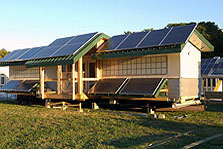
 Enlarge image
Enlarge image
The University of North Carolina at Charlotte house uses Kal Wall panels, which look like windows. They are actually highly insulated translucent panels that let in a lot of light but little heat.
(Credit: Warren Gretz/U.S. Department of Energy Solar Decathlon)
Who: University of North Carolina at Charlotte
What: Solar House
Where:
University of North Carolina at Charlotte
9201 University City Blvd.
Charlotte, NC 28223
Map This House
Public tours: Not available
Solar Decathlon 2002
University of North Carolina at Charlotte: Waiting for What's Next
The University of North Carolina at Charlotte planned to use its solar-powered house as a demonstration facility after the U.S. Department of Energy Solar Decathlon 2002. However, the house is now in storage behind campus near the recycling department's headquarters waiting for what's next.
Several complications prevented the university's desired outcome from materializing. Originally, the team intended for the state energy office in Raleigh to use the house for educational purposes. This plan was later derailed by transportation costs. The school's recycling department then offered to salvage it, but this, too, did not occur because the house didn't meet commercial standards.
"There is a ray of hope," says Dale Brentrup, faculty architecture lead for the team. The school's chancellor has developed a new Charlotte Green Initiative to encourage sustainable practices on campus. "It does have potential in this light, not as a house per se, but rather as the elements that went into the house," says Brentrup.
Brentrup has proposed siting the house's 16 solar panels at the school of architecture to recharge electric cars or supply electricity to the building. One colleague is interested in developing a materials mock-up facility to test various systems associated with sustainable building.
"We are continually thinking about ways to leverage the investment we made in the house," says Brentrup.
Although additional complications are sure to be on the horizon, they will not dampen the university's hopes of finding a meaningful purpose for the house and its parts.
"We're just opening a new history," says Brentrup.
